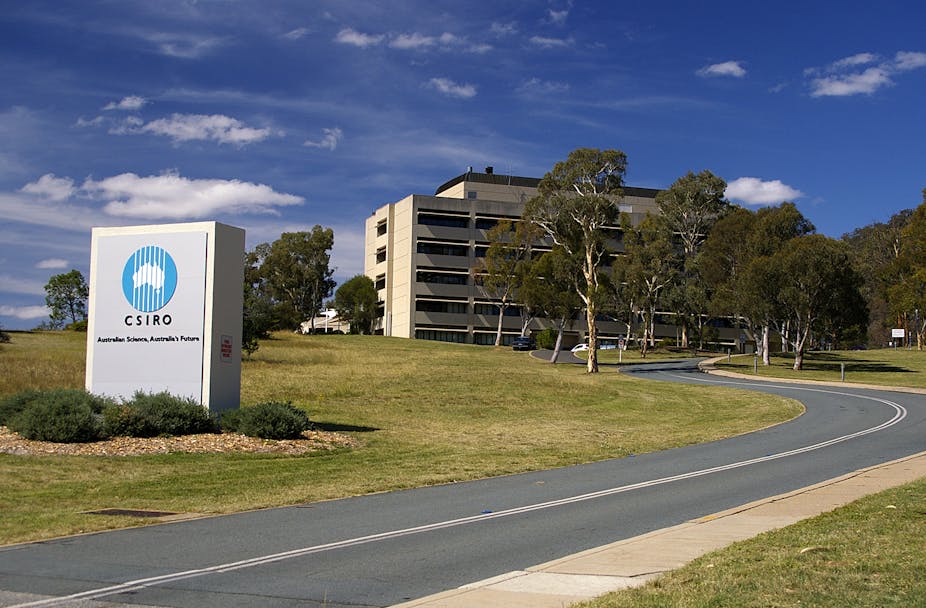What happens to CSIRO when the federal government decides to strip away A$111 million over four years from its A$733 million annual contribution to the organisation’s budget? We are beginning to find out.
CSIRO, which has already suffered many budget cutbacks over the years, is reportedly set to make a series of cuts to its environmental programs, closing eight sites and reducing funding to key research areas including geothermal energy, liquid fuels, carbon capture and storage, and climate change.
At the same time, funding for CSIRO’s research on coal seam gas is likely to increase. We might speculate that the changes are a deliberate strategy of investing in programs that are likely to impress the government and head off any more future cuts. But is that in Australia’s best interests in the long run?
Australia already lags behind
Research and development (R&D) is important to countries’ economies. In tough economic times, R&D can bring new innovations that can support emerging sectors.
Yet Australia invests relatively little in R&D compared with other developed countries. At 0.5% of GDP, Australia’s government spends less than the OECD average of 0.8%, and much less than Finland, Denmark, South Korea (all 1.1%) and the United States (0.9%).
CSIRO has a mandate to do R&D that benefits Australian industry, helping to bridge the gap between new research ideas and commercialisation.
It is a world-class institution with an outstanding publication record, and has developed many innovations that are used globally – most notably Wi-Fi, but also polymer banknotes and the buffalo fly trap to name just a few. (CSIRO’s inventiveness has even earned its own Twitter hashtag, #thankcsiroforthat.)
Given its past successes, it certainly seems short-sighted to cut CSIRO’s funding. But it is not a surprising move by a government that favours reducing spending and taxes to create a supposedly more efficient economy.
A more intriguing question is why CSIRO has responded by opting to cut funding to clean energy and climate change programs. We don’t know what the actual strategy is, but CSIRO is mostly publicly funded and we can assume that it will strategically orientate its research objectives to maximise its chances of maintaining government funding without any more cuts.
So perhaps we can’t blame CSIRO for scaling back its climate change and renewable energy programs. It may just be holding up a mirror to the federal government’s apparent reluctance to engage on climate change, with its pledge to repeal the current carbon legislation in favour of a A$2.55 billion direct action plan, despite many analysts saying it will be less effective.
Backing the wrong horse?
The problem with this strategy is that the technologies that most need government support are those that are still emerging or which don’t have the backing of big companies with a vested interest.
Hot rock geothermal, concentrated solar thermal and liquid biofuels are all technologies that have the potential to be competitive, but which are currently too expensive for investment companies to get on board.
While carbon capture and storage (CCS) is a very worthwhile technology to pursue, the reduction in CSIRO’s funding for CCS research is probably a sensible move. Successful demonstration of CCS will benefit existing billion-dollar companies with interests in coal mining and coal-fired power generation, which should be able to fund their own R&D.
CCS is hugely expensive, because it needs to operate at large scales and is a complex process with several steps – capture, compression, liquefaction, transport, and storage. The initial capital outlay for a demonstration plant will be vast. But if huge coal companies want to save their business, they should invest in CCS themselves.
Removing government funding for coal seam gas would also be the right thing to do for the same reason – but here CSIRO has apparently fallen into line with government policy. It is not yet clear if the optimal pathway to very low emissions is via gas – although many, including the International Energy Agency, believe it is.
Committing to using fossil gas exposes us to the risk of increasing gas prices that are likely with the expansion of the liquefied natural gas export industry. This will result in Australians paying the high international price for gas. And while gas has lower greenhouse emissions than coal, it is still a fossil fuel that emits significant amounts of carbon dioxide.
CSIRO is supposed to be investing in new technologies that, with any luck, will impress the corporate sector enough for them to start investing in more sustainable energy. CSIRO is at the mercy of government funding, and it appears that the government is forcing CSIRO’s hand towards options that are not in our long-term best interests.

